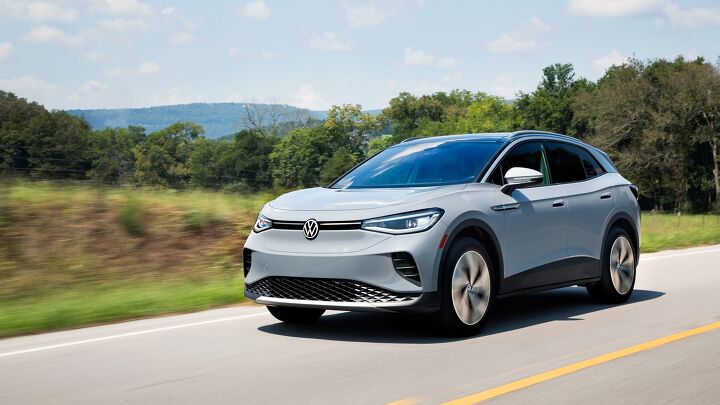Notable Updates are Coming to the VW ID.4 for 2024, but Only the More Expensive Models

Volkswagen has sold tons of ID.4s, but the EV is getting an update heading into the 2024 model year to keep it current. Changes include more tech, new advanced driver assistance features, but they’re limited to higher, more expensive trim levels.
The ID.4 rolls into the new year with the same battery and powertrain options it had before, but tech improvements should help it remain competitive. It gets a new 12.9-inch infotainment display, and VW equips heated and ventilated front seats for the ID.4 Pro S and more expensive trims. The interface now includes backlit controls, and the system has more powerful processors for more responsive operation. There’s also a new drive motor for models equipped with the larger 82 kWh battery pack.
Those changes won’t trickle down to the least expensive models, so buyers of the cheapest ID.4 will get the same laggy infotainment system and dark buttons from the previous model. It also carries over its middling 206-mile range and offers only rear-wheel drive. The larger battery pack brings significant upgrades for 2024, including an 81-hp increase, more than a 170-pound-foot boost in torque, and an almost two-second decrease in its 0-60 mph time.
Though it’s disappointing that VW didn’t make more substantive changes to the entire ID.4 range, it remains the only European EV that qualifies for federal tax credits in the United States. VW started building the SUV in Tennessee and sources batteries from SK On, giving the vehicle full access to the $7,500 credit. The new model is also expected to qualify.
Even the more expensive configurations are more affordable than many competitive EVs, but it’s important to note that VW hasn’t released 2024 pricing yet. The 2023 model started at $38,995 before destination and tax credits, which undercuts the Ford Mustang Mach-E and others, making the ID.4 one of the most affordable EVs on sale today.
[Image: Volkswagen]
Become a TTAC insider. Get the latest news, features, TTAC takes, and everything else that gets to the truth about cars first by subscribing to our newsletter.

Chris grew up in, under, and around cars, but took the long way around to becoming an automotive writer. After a career in technology consulting and a trip through business school, Chris began writing about the automotive industry as a way to reconnect with his passion and get behind the wheel of a new car every week. He focuses on taking complex industry stories and making them digestible by any reader. Just don’t expect him to stay away from high-mileage Porsches.
More by Chris Teague
Latest Car Reviews
Read moreLatest Product Reviews
Read moreRecent Comments
- Redapple2 All this BEV investment. A bigger impact (less oil consumption) would have been made if we had made PIG UP trucks smaller since 2000 and not HUGEr. (And raised gas tax by $2-3/gallon.)
- ChristianWimmer One of my clients is a company that is actually producing eFuels in Leipzig. Yes, they require a lot of energy to produce but this would not be an issue if Germany had nuclear energy or used the excess energy from wind and solar to produce these fuels. In such a scenario the energy losses wouldn’t really matter.Also, I am told that nations like Spain or the North African nations like Morocco or Tunisia could be ideal places to produce eFuels/Hydrogen due to their abundance of solar power. Again, the energy loses here would not matter since the energy used to produce these fuels is essentially “free”. If this path were pursued, Morocco and Tunisia could become wealthy nations and exporters of eFuels and Hydrogen. Countries with an abundance of solar or wind or hydro energy could be producing eFuels for their domestic consumption and export.Another argument which to me is irrelevant these days ist the poor thermal efficiency of ICE engines (25-35% gasoline, 40-45% diesel). One long trips with cruise control set to 130 km/h and even the occasional venture into the 180-200 km/h zone, my fully loaded (with my gear) A250 (2.0 4-cylinder 224-hp Turbo) can achieve an impressive gas mileage of 6 L / 100 km. That’s phenomenal - I am looking at six 1 liter bottles of water right now and that’s all my car needs to travel 100 km… amazing.So, I am a supporter of eFuels. I love internal combustion engines and if we want to use them in a climate neural way, then eFuels are a must. Also, to me every ICE car is way more sustainable and longer-lasting an an EV. Mazda, Toyota etc. are making the right move IMO.
- Blueice Once you infuse governmental unit regulation & [marketing] and taxpayerfunding, one knows quite well, dat the product or service isdestine to fail; which includes battery vehicles. Just axe yourself how revolutionary have your home batterydevices become ??? I am still waiting. after three decades, for a battery shaver whichonly requires charging two or three times per year.I am glad that I do not have a plug in Frau.
- Tassos Such a heavy breadvan on stilts, with so much HP, AND with ONLY 100 KWH Battery, I doubt if you will ever see 250 miles, let alone 300, under the best of conditions. In the winter, count on 150 miles range.And NO, it looks TERRIBLE. The only SUV that looks great is the RANGE ROVER.
- Tassos They sure are doing the right thing in the SHORT and MEDIUM term.As for the long term, in the long run, YOU'LL ALL BE DEAD, so WHO CARES.


































Comments
Join the conversation
Updating the ID4? Sure! Why not?
They'll do ANYTHING in hopes that you forget about the ID Buzz which is coming our REAL DAMN SOON.